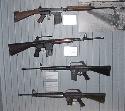

Springfield Armory Museum - Collection Record


Send us your own comments about this object.
| Title: | RIFLE, ASSAULT - U.S. ASSAULT RIFLE AR15 .223 SN# 000008 |
| Maker/Manufacturer: | STONER, EUGENE |
| Date of Manufacture: | 1957 |
| Eminent Figure: | |
| Catalog Number: | SPAR 3242 |
| Measurements: | OL: 97.7CM 38 1/2" BL: 50.8CM 20" 6 lbs. |
Object Description:
U.S. ASSAULT RIFLE AR15 .223 SN# 000008
Manufactured by Armalite, Costa Mesa, Ca. - Early version of the Armalite AR-15. Gas-operated which utilizes Swedish Ljungman AG42-type of gas-system. Select fire. Pronged flash suppressor is integral to barrel. Rate of fire 750 rpm. Wooden pistol grip. Weapon weighs approximately 6 lbs. Complete with 20-round detachable box magazine.
Markings:
Magazine housing: ARMALITE AR-15/HOLLYWOOD, CALIF. U.S.A./PATENT PENDING/000008.
Select switch: SAFE/SEMI/AUTO.
Magazine: 150 in pencil. 53.
Weapon transferred to the Museum on 6 January 1965. At that time weapon was appraised for $2,780.00.
Exhibit label: "AR15 (Armalite) - In less than nine months Stoner, working for the Armalite Division of Fairchild, developed the prototype AR15, a scaled down version of the AR10. Armalite's lack of large engineering and test staff, however, caused its prototypes to show poorly in tests conducted in 1958."
Notes: "Tests undertaken in 1952-53 with an M2 carbine chambering a shortened .222 Remington cartridge suggested that small-caliber high velocity bullets and light automatic rifles had a future. Though the experiments incurred official disapproval, the U.S. Army authorities prepared a specification in 1957 for a small-caliber selective fire rifle with a magazine capacity of at least 20 rounds but a loaded weight no greater than 6 lb. Accuracy and trajectory were to be at least equal to the 30-caliber service rifle cartridge to 300 yd. with wounding power equal to or preferably better than the .30 M1 Carbine pattern. The weapon was to chamber any suitable .22 cartridge.
Robert Fremont and James Sullivan altered the AR-10 to fire a modified .222 Remington round, avoiding lengthy ammunition development but accepting a penalty in the form of a small-capacity cartridge. High velocity could be achieved only through high chamber pressures.
The first rifles weighed 12lb with a loaded 25-round magazine and were 37.5in overall. They had steel barrels and hollow fiber-glass-reinforced plastic butts. Muzzles were plain cylindrical, the selector lever rotated up to the safety position and the charging handle still lay beneath the carrying handle. About 20 of these early guns were made. The encircled Pegasus' Armalite trade mark lay on the left side of the magazine housing above 'AR-15' and the Hollywood address.
Differences of opinion among Army experts had, meanwhile, increased the performance requirements from 300yd to 500yd. ArmaLite solved this by substituting the .222 Remington Special (known as the .223 Remington from 1959) for the original .222 round increasing propellant capacity. The AR-15 then gained a serious rival - the Winchester .224 Light-Weight Military Rifle ('WLAR') created by Ralph Clarkson by amalgamating the best features of the company's previous autoloaders.
Ten AR-15 rifles were delivered in March 1958. Tests undertaken at Ft. Benning, Aberdeen Proving Ground, and Fort Greely were highly successful. Though doubts about the lethality of small-diameter bullets persisted, the AR-15 and the WLAR performed better than the ,30-caliber T44E4. The ArmaLite was most reliable, though adversely affected by the use of 224E2 cartridges; the Winchester could not chamber 222 Remington special.
Trials suggested that the AR-15 charging handle should be moved to the rear of the receiver, as it could not be grasped through an arctic mitten and became too hot to hold during rapid fire. The safety position on the selector was altered to point forward, barrel weight was increased, and a flash suppressor was added. Magazine capacity was reduced to 20 rounds to compensate for weight added elsewhere.
Fierce opposition from the Office of the Chief of Ordnance to the small-caliber high velocity concept was soon magnifying problems all out of proportion. An examination of optimal calibers then led to the rejection of 222-caliber in favor of 258.
Rifle trials recommenced on 1st December 1958, but the M14 was reaffirmed as the 'only rifle suitable for military use'; not surprisingly, FairchilThe first Colt-made rifle ('AR-15 Model 01') were completed in December 1959, and modest orders were soon being fulfilled for Malaysia and India. The butts and handguards of the earliest guns had a mottled brown finish, later painted green. A rampant Colt trademark lay on the left side of the magazine housing, above 'ARMALITE' (plus 'AR-15' on later examples), 'Patents Pending', the designation '01' and the serial number.
By 1960 Colt was advertising that, among other things, the AR-15 could fire more shots without cleaning than any rival. The U.S.A.F., actively seeking to replace obsolescent M2 Carbines, then requested that the AR-15 be reviewed. Trials confirmed accuracy and reliability, the failure rate being less than three rounds per 1,000, and the 223-caliber rifle was grudgingly cleared for Air Force scrutiny.
Trials were so encouraging that the U.S.A.F. asked for 8500 guns. Congress rejected the request, but growing interest in Vietnam could not be ignored. In January 1962, therefore, the 5.56mm Rifle AR-15 (later XM16, then M16) was classified as U.S.A.F. standard." - John Walter
References:
Kulek, Walt & Scott Duff. THE AR-15 COMPLETE OWNER'S GUIDE. Scott Duff Publications. Export, Pa. 2000.
Walter, John. RIFLES OF THE WORLD. 2nd Ed. Krause Publications. Iola, Wi. 1998.